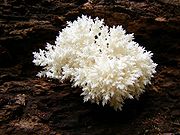
After a lifetime of wanting to, but never quite getting around to it I visited Tirtiri Matangi a while back with St John's trip (Tiffany is leader with elder two girls going).
Purchased a great book on New Zealand Fungi it has been a wonderful book as it is designed for laymen such is myself. It has been great to explore our gardens with the kids and finding all sorts of fungi then finding them in the book. Also doing spore prints for the first time - they produce wonderful patterns. We use chipped wood as a mulch, and this mostly comes free from arborists working locally. Thus a truck load has a large variety of different woods, from various locations. Thus in Autumn our gardens are a treasure trove of fungi.
Once knowing the name then find interesting stuff for example a few years back I was tramping in to the Aunanui falls in the Kiamia's. We came across a piece of what looked like white coral, but it was a fungi growing on tree (picture to left from Wikipedia). Turns out it is called
hericium coralloides (not coral in its name) with common name Icicle Tooth. Well a quick web search reveals that this a edible fungi. And apparently a good on to boot.

Things like this intrigue me. Clearly extreme caution needs to be exercised in eating fungi that are found in the wild. I wonder what nutrients we are missing by not eating them. I wonder about growing things like this commercially so that people around the nation and world can have more variety in their food.
As a husband and father the risks of trying new fungi, even ones that should be clearly distinguishable like this coral like fungi, outweigh the possible nutritional benefits. However in saying that I can collected and fryed up wood-ear jelly also known as Taraniki Wool this was an important export crop from Taraniki as the land moved from bush to farm. Mixed in with other mushrooms it was ok, but looking like and having texture of leather, I doubt it would make a tasty dish by itself. This fungus is easy to identify, as it is the only wood ear fungi in NZ (picture below, pic credit)




































